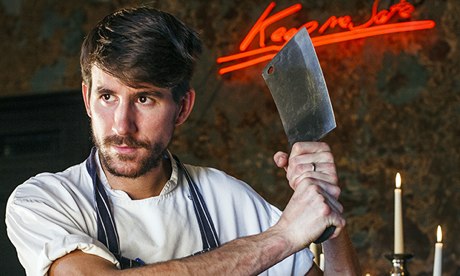
Murderous pasts, hangings, skeletons in the basement: to paraphrase Loyd Grossman, who would eat in a place like this? Lots of us. Far from putting off diners, macabre backstories are a boon for pub owners and restaurateurs, especially at Halloween (last year Brits spent £268m celebrating). Talking up a good ghost story helps attract trade, too. Rebecca Holloway of VisitEngland says: "Spooky stories help create an authentic sense of place and a USP." Whether the stories about a pub or restaurant's past are verifiable truths or torrid myths hardly seems to matter. "There are plenty of mysteries still left unsolved, and it is this uncertainty that continues to draw diners," she adds. Leaving aside questions of taste (how much time has to pass before we'll happily dine where tragedy occurred?), here are six spots with ghoulish pasts.
Marsden Grotto, South Shields
Dining in a cave is one of the biggest draws at this restaurant. A juicy tale involving smugglers such as Jack the Blaster doesn't hurt, either. The space was first made habitable by Jack, who blasted through a cave wall and turned it into his home, where he ran an underground supper club (a good two centuries ahead of the curve). Jack allegedly supplemented his income by storing contraband goods. Eighteen skeletons, believed to be fellow smugglers, were found during excavations, and the restaurant is said to be haunted by the smuggler who shopped Jack to Customs.
The Ten Bells, London
Hipsters, suits, Jack the Ripper tourists: the Ten Bells pub in Spitalfields draws an eclectic crowd. For the latter group, the fact that Ripper victim Annie Chapman had her last drink here is of interest, and the pub was also a stomping ground of another victim, Mary Jane Kelly. If you find all this distasteful, the Ten Bells is worth visiting for other reasons – it is a well-preserved Victorian boozer, and on the first floor is one of the capital's most exciting restaurants, Upstairs at the Ten Bells. Here you can dine on experimental, modern British dishes with no Jack-tat in sight.
The Manor at Weston-on-the-Green, Oxfordshire
Fans of Hilary Mantel's Bring Up the Bodies will be familiar with Sir Henry Norris, a key figure at the court of Henry VIII and an alleged lover of Anne Boleyn. Norris was executed by axe for treason and adultery at Tower Hill. His ghost has supposedly been spotted at his former home, The Manor at Weston-on-the-Green, where you can dine on seasonal dishes such as Oxfordshire wild boar in the 11th-century baronial hall.
The Well House Tavern, Exeter
Upstairs: antipasti sharing platters and Otter Ale-battered fish and chips. Downstairs: skeletons. The basement of the Well House Tavern is home to bones originally believed to be those of a young woman who died from the Black Death. But analysis by archaeological pathologists has revealed that the remains belong to two people. Local rumour has it that they are the romantically linked John the monk and Martha the nun, who threw themselves down the Cathedral Yard well to be together in death.
Skirrid Mountain Inn, Monmouthshire
The notorious "hanging" Judge Jeffreys, who gave out death sentences like sweets, supposedly heard trials on the ground floor of this Welsh inn. The storeroom was a jail cell, and convicts were hung from the oak beams over the stairwell. Something to think about while you tuck into Welsh sirloin or minted local lamb from the pub's hearty menu.
Bleeding Heart restaurant, London
With its dark red walls and heart logo, this French restaurant makes the most of its site as one of London's most lurid urban myths. According to a story popularised in the Ingoldsby Legends – a Victorian compendium of ghost stories – Lady Elizabeth Hatton held a winter ball in Hatton Garden in 1626. A mysterious man with a hunchback and a clawed hand (variously described as a European ambassador or the devil) danced with Hatton, then led her outside. She was supposedly found the following morning, murdered, her heart still pumping blood.

